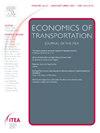Drone-as-a-Service for last-mile delivery: Evidence of economic viability
IF 1.7
3区 工程技术
Q2 ECONOMICS
引用次数: 0
Abstract
An economic viability of last-mile delivery via drones is assessed, offering an investment model comparing traditional motorcycle delivery to drone-based alternatives. Two drone investment options — purchase or lease (Drone-as-a-Service) — were introduced. The proposed last-mile delivery model considers capital and operational costs, calculating Net Present Value(NPV) and Return of Investment (ROI) per investment scenario. For the operational expenses, the energy consumption model for the motorcycle and the drone is formulated. Furthermore, three wind settings — low, medium, and high wind — were examined to account for environmental factors impacting drone performance. The investment model has been formulated and then validated considering the relevant literature as well as realistic information collected during a semi-structured interview with industry experts The findings affirm the financial feasibility of adopting drones for last-mile delivery. Drone-as-a-Service emerged as a more profitable choice, exhibiting improved NPV and ROI over owned drones or motorcycle delivery. Emphasizing DaaS in the investment model presents a probable scenario for the logistics industry, easing their transition to drone technology. Evidence of DaaS viability is of value since it could convince risk-averse distribution vendors to adopt drone delivery.
最后一英里送货的无人机即服务:经济可行性的证据
评估了无人机最后一英里配送的经济可行性,并提供了一个投资模型,将传统的摩托车配送与基于无人机的替代方案进行比较。引入了两种无人机投资选择——购买或租赁(无人机即服务)。建议的最后一英里交付模型考虑了资本和运营成本,计算每个投资场景的净现值(NPV)和投资回报率(ROI)。对于运行费用,分别建立了摩托车和无人机的能耗模型。此外,研究了三种风力设置——低、中、高风力——以考虑影响无人机性能的环境因素。考虑到相关文献以及在与行业专家的半结构化访谈中收集的现实信息,我们制定了投资模型,然后对其进行了验证。研究结果证实了采用无人机进行最后一英里交付的财务可行性。无人机即服务成为了一个更有利可图的选择,与拥有的无人机或摩托车交付相比,它表现出更高的NPV和ROI。在投资模型中强调DaaS为物流行业提供了一种可能的场景,有助于他们向无人机技术的过渡。DaaS可行性的证据是有价值的,因为它可以说服规避风险的分销供应商采用无人机交付。
本文章由计算机程序翻译,如有差异,请以英文原文为准。
求助全文
约1分钟内获得全文
求助全文

 求助内容:
求助内容: 应助结果提醒方式:
应助结果提醒方式:


